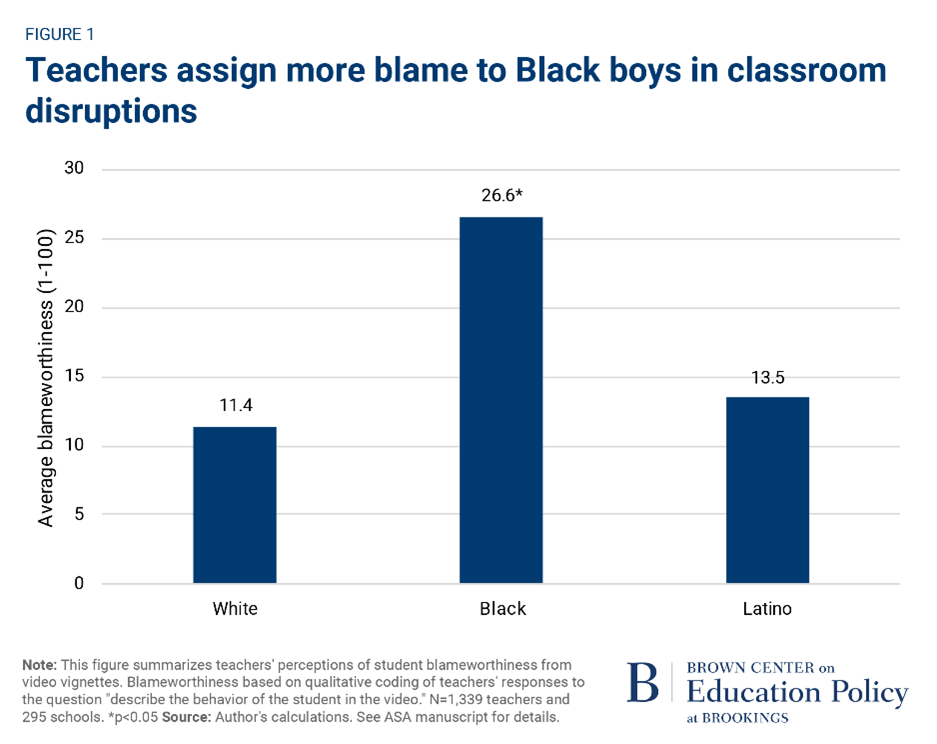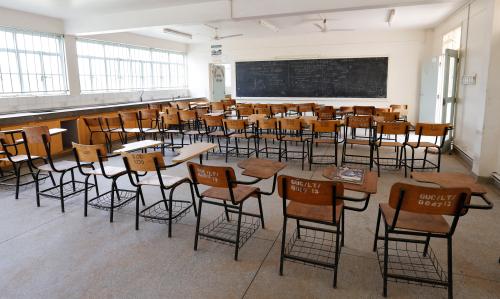Portions of this essay are excerpted from the article “Double jeopardy: Teacher biases, racialized organizations, and the production of racial/ethnic disparities in school discipline,” recently published in the American Sociological Review and a summary of this research published in Yale Insights.
Students will misbehave in school, and repeated misbehavior can be a serious obstacle to learning outcomes for all students in class. But what is the best way to deal with misbehavior issues—not only for the students who have their learning disrupted, but for the student doing the disrupting? And what exactly constitutes “misbehavior?”
Some schools take a “zero-tolerance” approach to discipline. At an extreme, they treat anything that could be construed as misbehavior as such and address it in a punitive manner, including by removing the misbehaving student from the classroom learning environment or from the school altogether. Such policies can go so far as to require that administrators harshly punish students for various types of misbehavior. These punitive ideologies assume that the threat of punishment will stop students from misbehaving and that students who do misbehave deserve whatever punishment they get.
I wanted to learn —when do teachers consider a student’s behavior a “misbehavior” and what factors influence teachers’ responses to student misbehavior? I also set out to investigate what factors shape schools’ decisions to punish students for this misbehavior. Specifically, I wanted to investigate how a student’s race or ethnicity—as well as the racial/ethnic composition of their school—may affect that student’s discipline outcomes.
Why might discipline disparities exist?
Latino boys are 30% more likely to be expelled or suspended from school than are white boys, and Black boys are 300% more likely to be expelled or face suspension. Why is this?
Prior literature has proposed three sets of explanations for these persistent racial/ethnic disparities: (1) behavior differences, whereby Black and Latino students are worse-behaved than white students, such that they exhibit higher levels of anti-social behaviors, aggression, and delinquency; (2) differential treatment, whereby Black and Latino students are punished more often and more harshly for comparable behaviors than white students; and (3) between-school sorting, whereby Black and Latino students disproportionately attend majority-minority and economically disadvantaged schools, which have more punitive disciplinary environments than schools serving white students.
Among these theories, the differential treatment and between-school sorting explanations have gained the most empirical support. For example, several studies show that school administrators punish Black students more harshly than their white peers for involvement in the same multi-student incidents. Moreover, studies on between-school sorting show that schools with large enrollments of Black and Latinx students are more likely to use harsher discipline practices than are schools with large white student enrollments, net of average student behaviors. On the other hand, the behavior differences explanation has been extensively investigated in the literature but repeatedly found to not fully explain racial/ethnic disparities in discipline. For example, in prior work, my co-author and I show that less than 10% of the Black-white suspension gap is due to racial differences in rates of behavioral problems.
However, our understanding of the relative contributions of these factors—and their implications for policy and practice—remains incomplete. First, few studies have directly tested the relative contributions of these different potential mechanisms driving racial disparities in discipline (see Owens and McLanahan (2020) for an exception). Second, several prior studies that support the differential treatment hypothesis rely on administrative and observational data sources—which leaves open the possibility that we are misattributing teachers’ racially/ethnically biased behavioral reports to differential treatment on the part of school administrators.
Using a video experiment to identify the causes of discipline disparities
I designed an experiment to examine how much of these disparities in discipline may be due to differences in between-school sorting (i.e., differences in the cultures, policies, and norms of majority-Black and Latino schools relative to majority-white schools) versus teachers’ differential treatment of students from differential racial/ethnic backgrounds for the same ostensible behaviors. I focused on high school boys since boys are disciplined at much higher rates than girls and the racial punishment gap is especially large in high school.
Working with a video team, I created videos of teenage white, Black, and Latino boy actors who performed sequences of identical misbehaviors. These sequences consisted of slamming a door twice, texting repeatedly during a test, and throwing a pencil into a garbage can and crumpling a test booklet.
I showed a sample of teachers these videos of teen actors portraying students misbehaving in class and then asked the teachers to evaluate the situation and what they would do in response. Over 1,300 teachers from nearly 300 middle and high schools across the United States were presented with a random video showing one of the boys performing one of the misbehaviors. The teachers then wrote a description of the student’s actions and indicated whether they would send the student to the principal’s office.
To better understand how teachers’ racial biases manifest in disciplinary actions, my team and I analyzed the phrases teachers used to describe the student. Did they use blaming words like disobedient or disrespectful? Or more empathetic language like concerning or defeated? Or was their phrasing more neutral? Using these analyses, our team created a “blameworthiness” rating for each student.
Finding 1: Evidence of differential treatment by race
Even though each of the “students” in the videos portrayed the exact same acts of misbehavior, the teachers were more likely to indicate that they would send the student to the principal’s office if they were Black than if they were white.
I found that teachers were 6.6 percentage points more likely to say that they would send a Black boy to the principal than a white boy. About 25% of the difference was driven by higher levels of blame —teachers used significantly more blameworthiness language for Black boys than for white or Latino boys (Figure 1). Even though both the Black and white students were behaving in the exact same way, the teachers perceived the Black students as behaving more negatively. In addition to this, even when the Black and white boys’ behaviors were perceived with the same level of negativity, the Black students were still more likely to be sent to the office.
Why do teachers treat Black boys differently than white boys? We can speculate about possible explanations. For one, it may be that some teachers interpret the behavior of minority students differently than that of white students. In a prior study, K-12 teachers read descriptions of repeatedly misbehaving students. Some of the students were named Darnell or Deshawn (names more stereotypical of Black students) and some were named Greg or Jake (names more typical of white students). The teachers found the recurring misbehavior to be more severe and more deserving of harsher punishment when the students had the stereotypically Black names.
Another possibility—one that Lewis & Diamond (2015) explore in detail—is that teachers anticipate different consequences for harshly disciplining Black and white students. For example, Black parents may be less likely to complain about strict discipline than white parents, and school principals may be less likely to take issue with teachers’ decisions to harshly punish Black students for similar reasons. If true, these types of considerations could affect teachers’ responses to student behavior.
Finding 2: Evidence of between-school differences
Interestingly, in my study, teachers did not exhibit racial bias in their assessment of Latino boys’ behavior relative to white boys. Instead, the higher rates of discipline for both Latinx and Black students can be partially explained by the punitive culture of the schools that they attend (e.g., schools that have “zero-tolerance” policies for transgressions). That is, Latinx students (like many Black students) typically attend schools where everyone is punished more often and more harshly, regardless of students’ race or ethnicity. This finding emerged because, irrespective of the race/ethnicity of the student in their video, teachers in schools with high percentages of Black and Latinx students perceived the behavior in their videos as being more “blameworthy” than did teachers seeing the exact same behavior in schools serving predominantly white students.
That is, I found that the types of schools in which teachers worked factored into their responses. Teachers from schools that serve a lot of minority students were more likely to interpret the student in the video as more blameworthy in general, regardless of the student’s race or ethnicity. It seems that in general, schools with a high ratio of Black and Latino boys have more punitive climates. This implies that the higher rates of discipline in these schools is due more to the culture of the school than to the behavior of the students.
Notably, such schools are more likely to use surveillance tactics, including installing security cameras and posting police officers in the schools. Increased security means that more students will get caught breaking school policies, even if the students themselves break policies with the same frequency as students who attend less-surveilled schools.
Considerations and implications
Despite its strengths, the video experiment approach I used has limitations. Namely, it considers only certain types of behaviors—from students and adults—and does not examine real classroom decision-making. Notably, too, my study focuses on boys. However, blaming bias could be equal or larger against Black/Latina girls than boys if it is compounded by heightened backlash for defying gendered behavioral expectations. I hope to see future work explore more aspects of discipline disparities, including the causes of disparate suspension rates for girls of different races and ethnicities.
Broadly, this research shines light on disparities in how the behaviors of students of different races and ethnicities are viewed and treated. To move forward, there are a variety of policy changes that school administrators could consider. One potential change is to clarify or change the criteria required for a referral to the principal’s office. Another is to offer empathy interventions—which research suggests may effectively reduce suspension rates and racial disparities. For example, teachers could be challenged to consider why a student might misbehave (such as conflict at home or a lack of nutritious food). Or, schools could implement teacher coaching programs for supporting teachers’ development of culturally responsive classroom management techniques, which has gained support in research. Schools could emphasize restorative justice techniques, like mediation, over the punitive techniques and climate that currently exist. School leaders also could assess whether potential hires favor such techniques over a punitive approach and hire applicants whose philosophy aligns with the culture they wish to create.
Ultimately, my belief is that the interventions that are most likely to prove to be effective in reducing disproportionality in discipline are those that help transform school culture more broadly. Such cultural transformations will create the school contexts that reduce the need for referrals in the first place—such as by increasing student-teacher trust and teacher cultural competence and empathy, and by putting into place the structures that support teachers in accomplishing their aims without removing students from the classroom.
To do so, I believe that school administrators should identify which unique set of factors contributes the most to discipline rates and disparities at their particular schools. Understanding the complex mechanisms driving persistent discipline disparities is critical for identifying the most promising solutions.
The Brookings Institution is committed to quality, independence, and impact.
We are supported by a diverse array of funders. In line with our values and policies, each Brookings publication represents the sole views of its author(s).









